Isuzu Responds to Reported DPF System Troubles
by Ranger Kidwell-Ross
 Over time, the WorldSweeper office has received a number of reports from parking lot sweeping contractors concerning trouble they were having with the DPF systems on their Isuzu chassis. As a result, we distributed a query to members of the World Sweeping Association.
Over time, the WorldSweeper office has received a number of reports from parking lot sweeping contractors concerning trouble they were having with the DPF systems on their Isuzu chassis. As a result, we distributed a query to members of the World Sweeping Association.
This informal survey resulted in more contractors coming forward with their experiences on the topic. You may read those 'case histories' in our previous article (link opens into a new window). In fact, we suggest you do so prior to reading this follow-up with two of Isuzu Commercial Truck's top U.S. managers.
The following information is based on an audio podcast interview held in May of 2014 with two of the top managers of Isuzu Commercial Truck of America. Mike Rossetti is Director of Field Operations for the company, while Jim Barnes is Manager of Regional Fleet Sales.
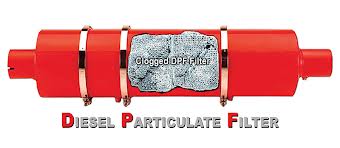 First, some background: The diesel particulate filter (DPF) systems now installed on newer diesel engines in the U.S. marketplace are a federally mandated change designed to reduce emissions nationwide. The first DPF units on Isuzu engines first appeared in 2007, on the 2008 model year trucks. There is no question that the systems work to reduce diesel exhaust emissions.
First, some background: The diesel particulate filter (DPF) systems now installed on newer diesel engines in the U.S. marketplace are a federally mandated change designed to reduce emissions nationwide. The first DPF units on Isuzu engines first appeared in 2007, on the 2008 model year trucks. There is no question that the systems work to reduce diesel exhaust emissions.
Diesel particulate filters have a catalyst in front of them that generates heat. Enough heat must be produced to start a regeneration of the soot particles that become trapped in the diesel particulate filter. In order to do this, the vehicle must be running at a speed of over thirty miles per hour. Vehicles that run for significant distances at a lower speed, such as parking lot sweepers, have an exhaust system that is too cool to allow a regeneration. As a result, soot can build up to an excessive level.
Because both street sweepers and parking area sweepers spend a significant amount of time traveling at speeds lower than 30 mph, the sweeping industry is a prime example of one that might need to learn the more complicated intricacies involved in initiating manual regeneration of the DPF systems in its sweeper fleet.
"In sweeping and similar industries, the most important key to efficient operation is driver education," said Rossetti. "The people who do low speed operation, like sweeper operators, may drive far enough to the location where they start sweeping to initiate a standard, automatic DPF system regeneration. However, if they are very short trips that are not enough to do an automatic regeneration, at some point the operators must initiate a manual one. Unfortunately, this means the vehicle cannot be moved for about 20 minutes."
Here's how the system works: The vehicles are equipped with a warning light on the dash; when it turns green it shows that a regeneration is taking place. Ideally, this occurs automatically, with no driver interaction needed whatsoever. However, if for some reason the regeneration is interrupted, because the operator changes idle speeds quickly or does something else that causes the exhaust temperature to go down, the automatic regeneration process suspends itself until it gets to another optimum regeneration spot. At that point, the process will restart.
If that doesn't occur automatically, though, the soot will build up and that will increase the back pressure. Ultimately, the DPF system will become clogged such that the green light will turn yellow, which indicates that a manual regeneration must be initiated. To do this, the driver needs to put the vehicle into park and push the manual regeneration button. The green light will come on and it will take from 15-to-20 minutes of complete vehicle inactivity for the process to complete.
During this time it is important to note that the operator must not touch the brakes or accelerator pedal or put the vehicle in gear, since any of these will suspend the regeneration. Keep in mind, though, that when the yellow light comes on the regeneration does not have to be performed immediately. However, in a somewhat indeterminate number of miles the system will move to 'red light status,' which does require an immediate manual regeneration. If the vehicle were to be driven very far after the red light comes on, the system will go into what we call 'limp home mode' and must be taken to an Isuzu dealership to have a regeneration initiated by a scan tool.
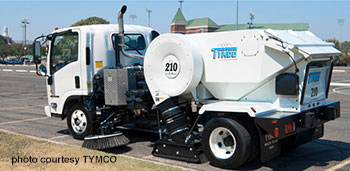 The intricacies of the DPF regeneration system is an area where operator training is critical. When a manual regeneration process is started, the driver pushes the regen button, the light flashes and then the green light comes on. Untrained operators may think "Oh, now it's okay to continue driving or otherwise operating the vehicle and the regeneration will continue behind the scenes." That is not the case with manual regenerations: The vehicle must be left in park during the entire manual process.
The intricacies of the DPF regeneration system is an area where operator training is critical. When a manual regeneration process is started, the driver pushes the regen button, the light flashes and then the green light comes on. Untrained operators may think "Oh, now it's okay to continue driving or otherwise operating the vehicle and the regeneration will continue behind the scenes." That is not the case with manual regenerations: The vehicle must be left in park during the entire manual process.
Plus, as stated above, if the operator does most anything to the vehicle's controls during a manual regeneration the green light will go out, indicating the process has been interrupted. Ideally, in the case of parking lot sweeping, the operator can hopefully get to a spot where there is a task that needs to be done outside the vehicle: backpack blowing, changing out garbage bags, etc. When street sweeping, it's not that simple and in all likelihood the driver will have to sit and wait for the regeneration process to complete.
One sweeping contractor interviewed for the first article in this series said they had started performing a manual regeneration after every shift, in an attempt to solve their DPF plugging issues. Rossetti says that is, in most cases, an extreme response. Also, remember that if a regeneration is not needed then the vehicle's DPF system will not allow a regeneration to occur.
Remember that if a regeneration is not needed then the vehicle's DPF system will not allow a regeneration to occur.
and
If a manual (also called a 'selectable') regeneration is initiated and then interrupted, the next automatic regeneration – which would normally happen when you're going down the road fast enough for that to take place – will be inhibited.
"You cannot force the truck to regen if the vehicle determines that it is not necessary," said Rossetti. "If they want to try doing that at the end of each shift that would be fine, but they need to keep in mind that the vehicle would only go into regeneration if it was necessary. And, if a manual (also called a 'selectable') regeneration is initiated and then interrupted, the next automatic regeneration – which would normally happen when you're going down the road fast enough for that to take place – will be inhibited. You always have to let it complete if you do a selectable regen."
Rather than after every shift, Rossetti said they have been successful with a number of sweeping companies via recommending a selectable regeneration be initiated once per week. If needed, the system will regenerate, thus minimizing the possibility a manual regen will need to be done during the rest of the week.
"One problem we've seen on a somewhat widespread basis, though," said Rossetti, "is drivers who disregard the lights when they come on. They'll ignore them to the point that they end up in "limp home mode" and that is not what anyone wants to occur."
It was also suggested that the frequency of DPF regen requests occurring should be part of the vehicle's log book. This would be especially helpful for parking lot sweepers that are being taken out on a similar route every night. Over time, this would show how often that regenerations have occured automatically and/or have been required on a manual basis. Using this information, a manual regeneration protocol could be established for that particular machine, one that would minimize time loss for the process.
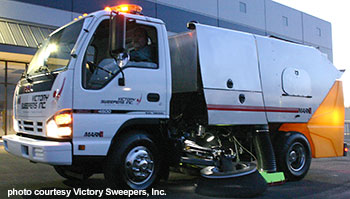 Remember: Once the chassis light turns yellow, there are an indeterminate number of miles of operation left before the red light comes on. This primarily depends upon how plugged the filter has become and the speed of subsequent operation. In most cases, says Rossetti, there is ample warning before the yellow light turns to red. And, keep in mind that a regeneration will occur automatically as long as the vehicle is traveling at highway speeds of at least 30 mph, because that's what it takes to heat the exhaust enough to turn the soot into ash. However, operators need to be well trained about what to do when the yellow light comes on, especially if they will not be traveling at highway speeds soon.
Remember: Once the chassis light turns yellow, there are an indeterminate number of miles of operation left before the red light comes on. This primarily depends upon how plugged the filter has become and the speed of subsequent operation. In most cases, says Rossetti, there is ample warning before the yellow light turns to red. And, keep in mind that a regeneration will occur automatically as long as the vehicle is traveling at highway speeds of at least 30 mph, because that's what it takes to heat the exhaust enough to turn the soot into ash. However, operators need to be well trained about what to do when the yellow light comes on, especially if they will not be traveling at highway speeds soon.
Keep in mind that the green light may come on signaling an automatic regeneration is trying to take place. However, if the operator starts going too slow for the regeneration process at any time during the 20 or so minutes needed, the light may go off again without a regeneration taking place. This may happen several times; it's not uncommon for a 'good' regeneration record to be that automatic regeneration takes place only 75% of the time. If regens are interrupted repeatedly, though, at some point the yellow light will come on signaling that a manual regeneration must be initiated. Rossettis says that his suggestion is not to worry about any repeated green light sequences unless a yellow light comes on. Then, and only then, is operator action needed.
"We have some people who think they have to pull over or some such when the green light comes on," said Rossetti. "They don't; just operate the vehicle normally because it's doing what it's supposed to. If the yellow light comes on you need driver interaction somehow, but until then I recommend not paying any attention to it."
For example, if the yellow light come on during parking lot sweeping, and you know you have another half hour to go at low speeds before you will be traveling at highway speeds that will allow regeneration, you can safely finish the job. It's like when the low fuel warning light comes on. That doesn't mean you're out of fuel. It does mean that you need to start heading to a fueling station. The same with when the yellow light comes on; you need to start thinking about regeneration. Then, when the red light comes on, you really need to think about regeneration.
In our previous story, one of the contractor's problems with his chassis DPF getting plugged turned out to involve his chassis having been outfitted with the wrong dipstick. When it showed full, he told us, the engine actually had about 2.5 quarts too much oil in the crankcase. Today's vehicles do not emit crankcase gases out onto the ground; rather, the system is completely closed. With too much oil in place, oil was injected into the system and the result was to clog up the DPF, and worse.
"Today we have a closed PCV system," said Rossetti. "With this you have normal crankcase pressure that develops and it will have small oil particles in it. What happened is these particles started getting into the intake system. Unfortunately, technicians thought that once they saw oil in the intake system the turbochargers were malfunctioning."
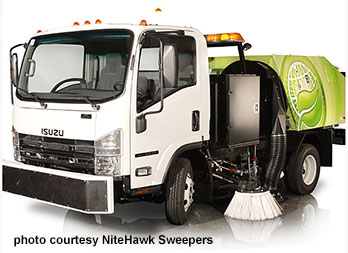 Isuzu learned that in those situations, if the amount of oil in the crankcase was reduced by 2.5 quarts it would limit the amount of oil that would end up in the intake system. That was the reason Isuzu changed the dipsticks, not because of regeneration issues.
Isuzu learned that in those situations, if the amount of oil in the crankcase was reduced by 2.5 quarts it would limit the amount of oil that would end up in the intake system. That was the reason Isuzu changed the dipsticks, not because of regeneration issues.
Starting in the 2008 model year, Isuzu trucks have a 'Vehicle Health Report Feature' added into the chassis system. What it does is monitor a variety of factors about how the truck is being operated: speeds traveled; hard braking; quick acceleration; fuel economy; idle time; highway driving time and more. Any Isuzu truck dealer can pull this data and help you to make a determination based upon the information found.
"The idea," said Rossetti, "is not to penalize the driver. Rather, we recognize that when we get into our normal vehicle we drive somewhat automatically to get from point A to point B. We use this tool [to help us in finding ways] to extend the brake life. I've also seen situations where fuel economy was increased dramatically just by changing the way the vehicle is being operated. These are all ways to keep more money in the owner's pocket."
In the audio interview with Rossetti, we also discuss at length the use of biofuels and their implication in the DPF system. In short, Isuzu recommends a maximum of 5% of biofuel be used in its vehicles. Rossetti also says they haven't seen issues with that amount as long as it is good quality biofuel, just like using good quality diesel. In extreme cases when people have used bad biofuel, he says, they've seen instances where the inside of the fuel inlet pipe was coated with white grease from using what might be called [inferior] 'restaurant quality biofuel.'
Caution must be taken to not use any type of fuel that will create an insufficient burn in the combustion chamber, because that will create soot. Remember those black clouds of smoke diesels were known for? Those exhaust pipe emissions were soot. Now, however, the soot has to be burned within the engine and having anything wrong with your engine that causes an insufficient fuel burn can lead to frequent regeneration and other engine troubles.
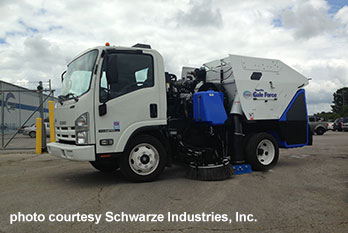 Rossetti stressed the importance of reading and understanding the Owner's Manual, especially in regard to the DPF system. Unfortunately, many people read that the diesel particulate filter needs to be removed and cleaned every 100,000 miles or 3,000 hours. Then, what they remember is 100,000 miles, not the part about the hours. Especially with slow moving vehicles like parking area sweepers, where relatively fewer miles are often put onto the chassis, the 3,000 hour mark needs to be tracked so the the filters can be maintained correctly.
Rossetti stressed the importance of reading and understanding the Owner's Manual, especially in regard to the DPF system. Unfortunately, many people read that the diesel particulate filter needs to be removed and cleaned every 100,000 miles or 3,000 hours. Then, what they remember is 100,000 miles, not the part about the hours. Especially with slow moving vehicles like parking area sweepers, where relatively fewer miles are often put onto the chassis, the 3,000 hour mark needs to be tracked so the the filters can be maintained correctly.
Owners in some industries may have many thousands of hours on their chassis by the time they reach 50,000 miles on the odometer. In some cases, parking area sweepers are in that category. When a chassis owner gets their 'health report' from their Isuzu dealer, they need to make sure to note the number of hours on the unit, not just the miles. The collected ash must be removed from the filters in order for them to be able to operate correctly. According to Rossettit, the overall chassis industry average is to have about 33 miles traveled for every hour of vehicle usage. And, he added, the hours are actually in the instrument cluster on Isuzu's 2011 and newer models.
In conclusion, you now have a good overview of how your DPF system operates. Be sure to go through your own vehicle Owner's Manuals for complete details. Go get the report on each of your Isuzu chassis at your dealership. Then, use that information to compare statistics on each of the drivers who operate them. Compare the data on your different operators and see how the driving skills of your best driver(s) can be ported over to those whose report card isn't as solid.
Modify your DPF and other service intervals as indicated by the data. Also scrutinize your driving data to see what suggestions you might give to your driver that might increase fuel economy. Ultimately, wise use of the data available, and keeping up with all of your service intervals correctly, are the keys to minimizing your total cost of ownership.
If you are having trouble with your Isuzu chassis, Rossetti says to consult with your local Isuzu dealership. Ask for an opinion about your percentage of requested vs. completed DPF regenerations: They will know if you are 'in the ball park' in terms of completion rate. If there are still questions, contact Isuzu's Consumer Relations Department.
As a complement to this article we offer an approximately 35-minute audio podcast interview with Mike Rossetti and Jim Barnes. Click here to access the .mp3 file.
Did this article answer your questions? If your organization has had similar issues with the newer Isuzu chassis, and they were not addressed in this article, be sure to let us know so we can see about adding the information.
If you have questions about your Isuzu chassis that cannot be answered by your local Isuzu dealer, your next step should be to call Isuzu Customer Relations, toll free, at 866-441-9638.
|